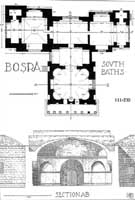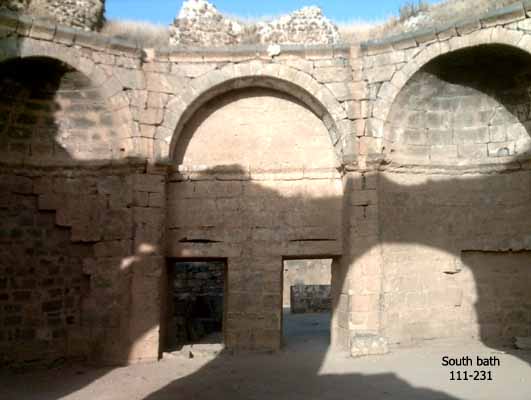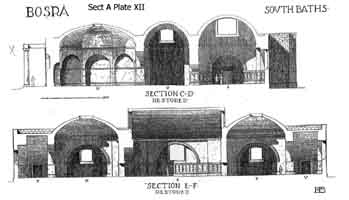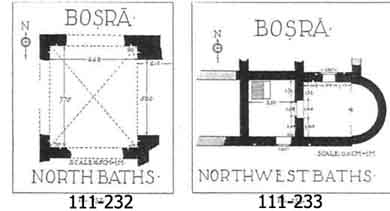|









|
|
Baths
|
SOUTH BATHS : Another large
and well preserved building among the ruins of Bosra, and one also
so completely hidden by modern constructions that it has been
scarcely noticed by travellers, is the great structure in concrete
faced with ashlar, which lies almost due south of the Nymphaeum, and
which I have called the South Baths to distinguish it from other
buildings in the ruins which undoubtedly served the same purpose.
Completely surrounded by modern houses, and divided within into no
less than five separate habitations which have no
intercommunication, it is extremely difficult to explore. It is
impossible to realize that the separate parts compose a single
whole, until one mounts to the roof of one of the vaulted chambers,
and observes the entire outline of the building from one spot. And
it would never have been possible to measure and to reconstruct the
plan of the building if the owners of the present houses inside the
ancient baths had not been exceedingly polite and hospitable. The
plan (111. 230) is T form, with the main entrance in the foot of the
T, toward the north, not far from the main east-and-west street of
the city, with which it was probably connected by a short colonnaded
street of its own. The ground plan does not resemble that of any
other baths that I have known in Syria; but the water conduits along
the top of its walls, the perpendicular grooves for water pipes in
all the wall surfaces, and the double faced walls with heating flues
between, all bear witness to the original purpose of the building,
and render the plan all the more interesting. The entrance was
dignified by an octastyle porch, of which one column is preserved,
extending across the entire facade. It consists of two arched
portals with a niche between them and one on either side. Within
these portals was the main hall of the baths - the apody-teriuin -
(N in Plan) an octagonal chamber slightly oblong (15 m. x 12.75 m0
with deep semicircular niches occupying its four oblique sides,
rectangular arched recesses in its east and west sides, the entrance
in its north side, and an arch on the remaining side leading into
the next chamber. Every angle carries a groove for a pipe. This
great hall (111. 231) is perfectly preserved but for its vault the
entire crown of which has fallen in, and for the break in the wall
which converted the arched recess on the west side into an entrance. |
|
 |
It serves to day as a cattle pen, and
the two portals lead into houses built in the ancient porch.
The next chamber (O) is a rectangle terminating at the east
and west in deep arched recesses almost as broad as the
chamber itself. These two apartments complete the leg of the
T. The middle chamber between the cross arms (S) is also
oblong, and had a great window to the south. The arms are
identical in plan, but differ slightly in measurements. Each
has three rooms, a square chamber with deep recesses to north
and south (R) and (T), a narrow oblong room (P and V) in the
ends of the arms, and, to the south of this, a small chamber
(p) and (u) in the angle, the western one of which seems to
have been a vestibule. Of these (P)and (p) are inhabited,
the original east wall having given place to a modern
wall, |
|
| and the arch between (P) and (R) having been
closed also with a crude wall of recent construction. The square
chamber (R) retains its original vault, and is used by the Mudir of
Bosra as a store house for tibn, or chopped straw. Rooms (S) and (T)
are used to house cattle, and there is a small hovel in the doorway
between them; while (V) and (u), like the corresponding rooms at the
opposite end, having their vaults intact, are inhabited. |
|
 |
| Section A-B (111. 230) and the left hand side of
Section C-D (PI. XIII) show the main hall in restored form. The
drawing of the restoration consisted simply in the representing of
plaster upon the walls, for which there is ample evidence, and the
completion of the curves of the vault. The extent of the standing
parts of the vault is shown by a dotted line on either side. This
vault, or, perhaps better, eight-sided dome, was a remarkable piece
of |
|
construction. It was built of the
usual material for vaults in the Haurān, i. e. volcanic
scoriae set in hard mortar. Its plan was irregular, having two
opposite sides longer than the other sides, and its form was
extremely low and flat, each segment being part of an ellipse
with its major axis horizontal. The section on the minor axis
(C-D) presents no very unusual aspect, but that on the major
axis (A-B) appears to have been something of a tour de force;
for the crown of the dome isnearly flat; yet
the curves of all the preserved portions, when produced, can
be made to give no other result. |
 |
|
|
The opening that I have placed in the
centre of the crown is taken from a similar feature in the only
vault in this building that is still in place. The vaulting of
chambers (O) and (S) is shown in Section C-D (PI. XIII)-, both were
certainly covered with tunnel vaults, lying east and west and having
windows in the lunettes below them, although nothing remains above
the springing of these vaults and the ledges of the windows. Chamber
(O) has a deep recess at either end, covered with a tunnel vault the
crown of which reaches up to the springing of the high vault. The
walls of this chamber were faced up with thin slabs of basalt with a
space for heating flues behind them; while chamber (S), if my notes
and original drawings are correct, has neither heating flues nor
water conduits in its walls. The drawing, Section E-F in Plate XIII,
gives a restoration of the vault system of the long row of chambers,
(P), (R), (S), (T) and (V), at the south. The narrow apartment (P)
is covered by a great tunnel vault of slabs laid upon the arches
which flank it. The curves of this vault leave room at either end
for a small upper chamber at the north, and a chamber larger than
(P) above that room on the south. The vault of (R) is intact. It is
a perfect example of the cloistered vault, or square dome, a form of
vault rarely found in extant examples in Syria or elsewhere. It is
composed of light volcanic scoriae set in good mortar, it has a
square opening at the crown, now covered with branches of wood,
reeds, straw and earth. Though this sky-light may have had a frame
of metal or of wood, it has none now; for the ragged edges of the
opening are entirely exposed. (T) seems to have corresponded in all
respects to (R); but (V) is wider than (P), though it was similarly
vaulted, and it had an arched entrance to the north where (P) has a
very thick and unbroken wall. The little chamber (u) seems to have
been a vestibule; for it has an entrance to the south ; it also had
more than one storey; while the corresponding little apartment (p)
appeal's to have a thick unbroken wall. But since it is inhabited,
is dark, and has mud plaster upon its walls, it may be that an
entrance here has been closed by its present occupants. A flight of
corbelled stairs leads to the roof at the west side of chamber (u).
The heavier walls of this entire building are standing, and the
arches which bounded almost every compartment and carried the vaults
are also in place; but the thin walls, or screens, which closed the
spaces under the arches have been, in most cases, removed to their
foundations. These are shown in hatched lines in the plan. They
constituted the side walls of many of the chambers, and, of course,
contained the windows, but being lightly built they were readily
carried away for later building operations. Only one has been
preserved, - that at the south side of the vaulted chamber (R) - and
this is plastered with mud on the outside, and is almost buried in
straw on the interior; but from what I could observe in the
semi-darkness, the window appears to have been filled with a grille
of stone work, like a simple window sash. The thin wall at the
opposite side of the chamber has been rebuilt in modern times." I
have restored these walls with windows in them in all the larger
spaces. The windows shown in the restorations of the spaces below
the tunnel vaults are based upon window sills, or bevelled ledges,
that are still in place.
Water conduits lined with the best opus signinum were carried around
the top of the walls on all sides and upon the partition walls.
Vertical grooves for water pipes are to be found in the walls of all
the larger chambers, excepting only (S). In the octagonal chamber
these were placed in the angles, were cylindrical in form, and were
concealed beneath the plaster; in other chambers the vertical
conduits were of rectangular section, and probably carried
cylindrical pipes of terra cotta. Heating flues were found in the
walls of (O), and fragments of marble, which I take to have been
panelling, were found in (S). I doubt if it is possible from the
plans herewith presented, and from the data given above, to identify
the purpose of the various compartments of these baths with any
certainty. There can be very little doubt that (N) was the
apodyterium, and (S), if it has no flues for heating, was probably
the frigidarium. Since (O) has heating flues it may have been a
tepidarium. This arrangement would leave the two domed chambers (R)
and (T) for caldaria, and the smaller rooms for sudatoria. The fact
that (T) and (R) were separated from (S) by partition walls with
small doorways in them probably indicates that they were to be kept
warmer; but it would seem unusual, and perhaps not altogether
convenient, to have the frigidaruim placed in such a position, with
reference to the other parts of the bath, that it would of necessity
have been the only means of communication between the tepidarium and
the caldaria.
The construction of baths is generally so different from that of
buildings of other kinds, and there is so little of ornamental
detail about them, that it is never easy to determine their date if
inscriptions and other dateable evidence are wanting. Fragments of
inscriptions have been found built into its walls; but I believe
these were, in every case, late walls erected to close the open
spaces below the great arches. The building is undoubtedly of the
Roman period of the second or third century, and may be as late even
as the beginning of the fourth century; but I should not attempt to
give it a date within these two hundred and fifty years. |
|
Central baths |
|
CENTRAL BATHS : This caption has
been introduced to explain an error of mine which was reproduced in
the Plan of Bosra before I had discovered it. The building west of
the Market, given the title "Central Bath" in the map, is not an
independent building as I originally supposed it to be, but was
connected with the Khan id-Dibs, or Market, as an integral part of
that building. The connexion between the two parts of the building
was not apparent until the plans were finally drawn, owing to the
presence of modern constructions between them. The presence of
vertical grooves, like those seen in baths, in one section of the
ruined building, suggested that the structure was part of a bath. I
now believe that these perpendicular grooves were used for some,
other purpose, perhaps to conduct water to a fountain in the Market. |
|
North Baths |
|
NORTH BATHS : Near the north wall
there are remains of a large building which was undoubtedly another
public bath. The ruins cover a large area in the midst of cultivated
gardens, but only one small section is standing. This is a four-part
vault of masonry supported by four stout angle piers (111. 232) with
perpendicular grooves for water conduits on their inner faces. To
the east of this is a large mound made up of fallen vaulting; but
all the quadrated building stones have long since been carried away.
No ground plan can possibly be traced here without excavations. The
vault construction and the water conduits of the standing part are
sufficiently like those of the South Baths to warrant the assumption
that the two buildings belonged to the same epoch. The condition of
this ruin, which has served for centuries as a quarry, makes it
clear that the ancient buildings, in order to be preserved, must be
located in some wholly deserted place or be inhabited from
generation to generation . |
|
Northwest Baths |
|
NORTHWEST BATHS. Less than 50 metres to the
southwest of the standing vault of the North Baths I found, in 1909,
two small apartments that had recently been excavated by the
natives. The walls, about 2 m. high, had rectangular grooves and
cylindrical conduits at frequent intervals, which suggest that these
also are remains of a bath. It is of course not impossible that this
structure belonged to the North Baths; but, because no connexion was
visible, I have treated it as a separate building. The construction
is, for the most part, in concrete doublefaced with blocks of basalt
for |
|
 |
|
which the natives were excavating; but the wall
between the two chambers was built, in part at least, of brick. The
plan (111. 233), so far as it has been revealed by the excavators,
consists of two rectangular rooms, the more easterly of which.
terminates in a niche, or exedra, almost as wide as the room itself.
There are unmistakable traces of other apartments to the north and
west of these two, but none has been revealed in the direction of
the North Baths, though excavations in that direction might bring
them to light. |
|
